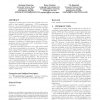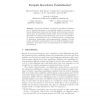52 search results - page 4 / 11 » Visualizing potential parallelism in sequential programs |
COORDINATION
2009
Springer
14 years 8 months ago
2009
Springer
A future is a well-known programming construct used to introduce concurrency to sequential programs. Computations annotated as futures are executed asynchronously and run concurren...
PPOPP
2012
ACM
12 years 3 months ago
2012
ACM
Graphics processing units (GPUs) are powerful devices capable of rapid parallel computation. GPU programming, however, can be quite difficult, limiting its use to experienced prog...
CCECE
2006
IEEE
14 years 1 months ago
2006
IEEE
To help programmers of high-performance computing (HPC) systems avoid communication-related errors, we employ a formal process algebra, Communicating Sequential Processes (CSP), w...
OOPSLA
2009
Springer
14 years 2 months ago
2009
Springer
The Task Parallel Library (TPL) is a library for .NET that makes it easy to take advantage of potential parallelism in a program. The library relies heavily on generics and delega...
LCPC
2009
Springer
14 years 9 days ago
2009
Springer
Abstract. We describe Fastpath, a system for speculative parallelization of sequential programs on conventional multicore processors. Our system distinguishes between the lead thre...


